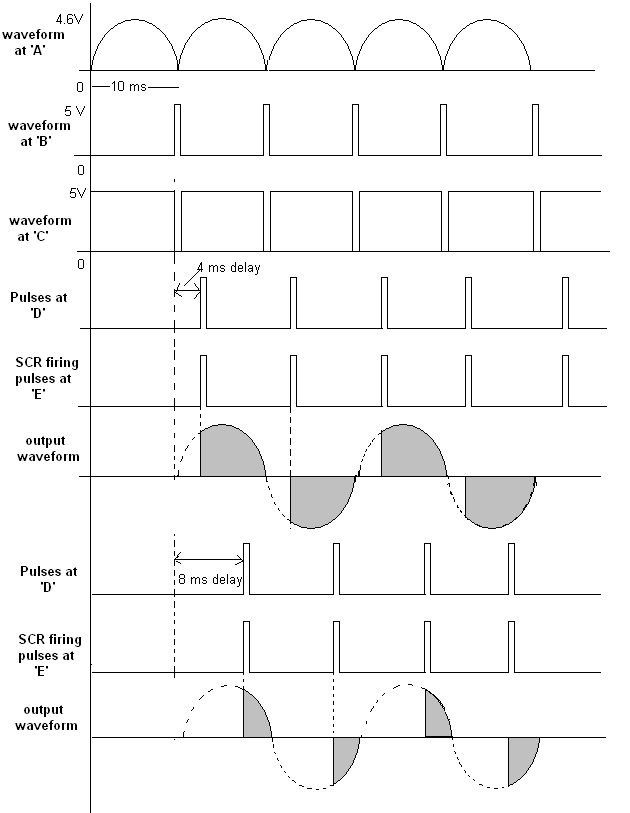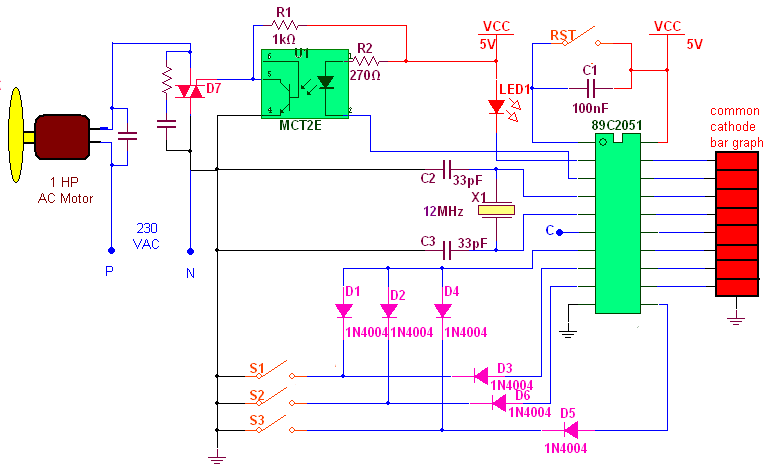Here is a very simple example of AC motor speed control given by changing firing angle of TRIAC with the help of micro controller 89C2051. Varying speed of AC motor by means of changing firing angle of any thyristor is very widely used method. One very nice example is fan regulator in which a fan motor is 1 AC motor used and its speed is varied using DIAC-TRIAC method. Here instead of using DIAC and other components for firing TRIAC here I am using micro controller 89C51 for this purpose.
A zero crossing detector circuit is used here to interrupt 89C2051 after every 10 ms. After getting an interrupt 89C51 will fire TRIAC after some delay from 1 to 9 ms. This will cut the current supplied to motor and so the speed of motor will reduce. Thus by varying the delay after which the TRIAC is triggered one can change the speed of motor.
Main circuit is a combination of two sub circuits.
- Zero crossing detector circuit
- Firing angle control circuit
Zero crossing detector circuit: –
Connections: – as shown in Circuit Diagram Tab1 transformer T1 step downs 230 VAC in to 9 VAC and this is given to bridge rectifier D1. This rectified output is directly fed to base of Q1 through resistors R1 & R2. Same rectified output is filtered through C1 and given to voltage regulator IC 7805. Output of 7805 is regulated 5 VDC that is given as biasing voltage for both transistors Q1 & Q2 (same regulated 5 V supply is given to main control section also). Both transistors are connected in switch configuration. The final output ‘C’ is given to main control section.
Firing angle control circuit: –
Connections: – as shown in Circuit Diagram tab2 micro controller 89C2051 along with opto coupler MCT2E (for triggering TRIAC) and common cathode type bar graph display (for indicating angle) are used for changing firing angle of TRIAC. Signal ‘C’ from zero crossing detector circuit is directly given to pin no. 6 that is external interrupt 0 (P3.2) pin. All port P1 pins are connected with anodes of bar graph display and common cathode of bar graph is grounded. One led LED1 is connected with P3.0 as shown. Pin P3.1 is connected with input of opto-coupler MCT2E. Output of MCT2E is connected with gate of TRIAC. TRIAC is connected in loop with AC motor and 230 VAC supply as shown. RC snubber circuit is connected is connected in parallel with TRIAC. Three push buttons S1 – S3 are connected with P3.4, P3.5 & P3.7 respectively through diodes. Pin P3.3 (external interrupt 1) is connected with all three push buttons through diodes D1, D2 & D4 as shown. A 12 MHz crystal along with 2 33pf capacitor is connected with crystal input pins. Capacitor C1 with push buttons RST forms power on reset circuit.
Operation
Operation: – to understand operation let us take a help of waveforms.

- As shown in figure the first wave form is full rectified wave that is fed to the base of Q1. Whenever this voltage falls below 0.7 V Q1 is switched off. So its output goes high.
- This will produce one very short positive pulse at ‘B’ as shown in figure as second waveform
- As this positive pulses are fed to Q2 which is again connected in switch configuration, it will produce one negative pulse at ‘C’ of same width of positive pulse. This is shown as third waveform
- Now as this negative pulse output is given to interrupt pin of micro controller. It will generate interrupt every time.
- After getting an interrupt micro controller will generate a positive pulse on P3.1 after some delay. This will turn off internal LED and due to that a positive pulse is produced at output. This is used to trigger (fire) TRIAC
- Depending upon the time delay in between interrupt and pulse on P3.1, the TRIAC is fired earlier or later.
- As shown In figure I have given wave forms for two different cases one for 4 ms delay and second for 8 ms delay
- In the first case for 4 ms delay the output positive cycle of AC wave is 60% of input so only 60% current is delivered to load (the dotted line shows part of wave form that has been cut)
- For second case 8 ms delay output cycle is 20% of input cycle so only 20% current is supplied to load
This change in delay is done through push buttons given. So let us see the functions of push button
|
Switch |
Functions |
|
S1 |
to switch on / off TRIAC |
|
S2 |
to increase delay by 1 ms |
|
S3 |
to decrease delay by 1 ms |
Led LED1 is used to indicate the TRIAC is on. Variation in angle is displayed on bar graph display. If angle is more, less current supplied to motor and motor speed is reduced less bars appears on display. If angle is decreased, current supplied will be more, speed of motor is increased and more bar appears on display.
The diodes D2 – D7 are connected in such a manner that whenever any of three push buttons, is pressed it will generate external interrupt 1.
When S1 is pressed first time it will enable external interrupt 0. So after every 10 ms external interrupt 0 is generated and that will start the entire operation. Pressing S1 again will disable external interrupt 0. Now no more interrupt is generated and complete operation is shut off.
On pressing S2 will increase delay by 1 ms (firing angle by 18o deg). So firing of TRIAC is delayed by 1 ms and amount of current supplied to load is decreased by 10%. Maximum delay is 9 ms (max angle is 162o deg). Bar is increased by 1 step.
In same manner when S3 is pressed delay is decreased by 1ms (firing angle by 18o deg) and load current increases by 10%. Minimum delay is 0 means full positive cycle is applied. Bar is decreased by 1 step.
The bar graph displays the variation in phase angle. More bars means angle is big and motor speed is low and vice versa.
Software logic: –
The complete operation is based on the software embedded in micro controller 89C2051. The software is written in C language. Different functions are used for different operations like ext1, ext0, delay and keydly etc. Here is the code with necessary comments which it elf explains all above functions.
Project Source Code
Project Source Code
###
#include<reg51.h>
#include <string.h>
sbit led1 = P3^0;
sbit s1 = P3^4;
sbit s2 = P3^5;
sbit s3 = P3^7;
unsigned int d1=0;
unsigned int d2=0;
unsigned int c=0;
bdata unsigned char byte;
sbit b0 = byte^0;
sbit b1 = byte^1;
sbit b2 = byte^2;
sbit b3 = byte^3;
sbit b4 = byte^4;
sbit b5 = byte^5;
sbit b6 = byte^6;
sbit b7 = byte^7;
void dely(void);
void incangle(void);
void decangle(void);
void delay(int d);
void shiftup() // raise the bar graph by one step
{
b7=b6; // shitf the bits one by one to up
b6=b5;
b5=b4;
b4=b3;
b3=b2;
b2=b1;
b1=b0;
b0=1; // insert 1 to first bit
}
void shiftdown() // decrease bar graph by one step
{
b0=b1; // shift all the bits down one by one
b1=b2;
b2=b3;
b3=b4;
b4=b5;
b5=b6;
b6=b7;
b7=0; // insert 0 to last bit
}
void keydly(void) //key debounce delay
{
unsigned int x,y;
for(x=0;x<100;x++)
for(y=0;y<1000;y++);
}
void decangle() //decrease delay by 1ms
{
EX1=0; //first disable all interrupts
if(d1>0)
{
d1--; // decrease delay
shiftdown();
P1=byte;
}
EX1=1; // enable interrupts before leaving
}
void incangle() // increase delay by 1 ms
{
EX1=0; // all other things remains same as above
if(d1<9)
{
d1++;
shiftup()
P1=byte;
}
EX1=1;
}
void delay(int d) // generates delay from 1 to 9 ms
{
int k;
TL0 = 0x17; // load timer 0 with 64535 = FC17h
TH0 = 0xFC; // so it will overflow after 1000 counts
TR0 = 1; // start timer
for(k=0;k<d;k++) // count overflows of timer 0 till
{ // desire delay is required
while(TF0==0);
TF0 = 0;
TL0 = 0x17;
TH0 = 0xFC;
}
TR0 = 0;
}
void int0(void) interrupt 2 // external interrupt 1 subroutine
{
keydly(); // after key debounce delay
if(s1==0) // for first key
{
c++; // increase counter
if((c%2)==1) // check even or odd
{
EX0 = 1; // enable external interrupt 1 if odd
}
else
{
EX0 = 0; // disable external interrupt 1
}
}
else if(s2==0) // for second key
{
incangle(); // increase phase angle
}
else if(s3==0) // for third key
{
decangle(); // decrease phase angle
}
}
void int1(void) interrupt 0 // external interrupt 1 subroutine
{
int t;
led1=0; // led1 is on
delay(d1); // after desired delay
pulse=1; // send pulse on p2.0
for(t=0;t<200;t++);
pulse=0;
led1 = 1; // led1 off
}
void main()
{
TMOD = 0x01; // initialize timer0 as 16 bit timer
P1=0x00; // P1 as output ports
P3=0xFF; // P3 as input port
IE=0x84; // enable external interrupt 1
while(1); // continuous loop
}
###
Circuit Diagrams
Filed Under: Electronic Projects




Questions related to this article?
👉Ask and discuss on Electro-Tech-Online.com and EDAboard.com forums.
Tell Us What You Think!!
You must be logged in to post a comment.